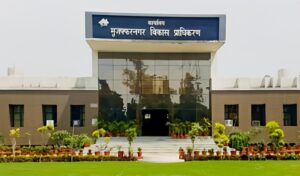A HISTORICAL OUTLINE
 In pages of history and revenue records, SARVAT was known as pargana which was given as JAGIR to one of the chieftains named SAIYED MUZAFFARKHAN by emperor SHAHJHAN. He founded the city of Un-Divided Muzaffarnagar in 1633 with lands of KHERA & SUJRU. His project was completed by his son MUNAWAR LASHKAR KHAN who in turn named the city after his father MUZAFFARKHAN.
In pages of history and revenue records, SARVAT was known as pargana which was given as JAGIR to one of the chieftains named SAIYED MUZAFFARKHAN by emperor SHAHJHAN. He founded the city of Un-Divided Muzaffarnagar in 1633 with lands of KHERA & SUJRU. His project was completed by his son MUNAWAR LASHKAR KHAN who in turn named the city after his father MUZAFFARKHAN.
But the recent finding of archeological site at village MANDI (Tehsil SADAR) in the west of river KALI takes the roots of district Un-Divided Muzaffarnagar to HARAPPAN civilization. Hordes of the gold ring like objects and other precious stones prove that the site was the part of the mature HARAPPAN culture and also an important center of trade during ancient times.
Proximity with HASTINAPUR and KURUKSHEHTRA indicates that this district was a hub of activities during the MAHABHARAT era. With exceptions of few findings of GREECO-ROMAN coins, there is hardly any direct mention of the region for a long period of time. But with the strategic location of MUZAFFAR NAGAR, it can be safely presumed that there were a lot of political as well as economic activities here. RAJPUTS, TAGAS and BRAHMINS dominated the area according to C.H.NEVILLE, I.C.S. in his compilation of Un-Divided Muzaffarnagar Gazetteer. Later JATS replaced the TAGAS.
Persian literature has mention of the place during TIMUR’s invasion of India. A large number of Hindus gathered at BHOKAR HERI on the banks of river GANGA to resist his armies according to TIMUR. But unorganized Hindu force was defeated by him in the year 1399.
Later on this district was adopted by the SAIYEDS of different clans. During Mughal period this area became a favorite resort of royal nobles of Mughal court and many of them obtained JAGIRS here.
The history of BARHA SAIYEDS is intimately connected with this district. But the derivation of word BARHA is very uncertain. The TIHANPURI SAIYEDS, JAGNERI SAIYEDS ,CHATTAURI family and the KUNDLIWAL family were famous families of Un-Divided Muzaffarnagar. In later part of Mughal era famous SAIYED brothers, HASAN and ABDULLA became KING MAKERS. The period of 1707 to 1720 was their prime time. But after fall of SAIYED brothers, the political scenario changed and Un-Divided Muzaffarnagar was plundered by SIKHS and other adventurers. Soon the British established themselves in India and 1826 Un-Divided Muzaffarnagar became a revenue district of EAST INDIA COMPANY regime.
During the first struggle for freedom in 1857 a lot of action was in the District. MOHAR SINGH of Shamli and SAIYED-PATHANS of Thanabhawan fought against the British and captured the Tehsil of Shamli. But later on the British army showed its brutality and recaptured the area. A lot of freedom fighters were done to death by them and this attempt was failed. After that attempts, the course of Indian National Movement changed and the Indian National Congress came to the fore. The educated elite took the path of peaceful constitutional methods. On the 6th of April, 1919 an office of Indian National Congers was opened in Un-Divided Muzaffarnagar under the leadership of Dr.BABU RAM GARG, Mr.UGAR SEN, and Mr. KESHAV GUPTA etc. The district became hotbed of freedom struggle and was frequented by national leaders like Pt. Madan Mohan Malviya, Mahatama Gandhi, Motilal Nehru, Sarojini Naidu, Jawahar Lal Nehru, Subhash Chandra Bose, Pt. G.B.Pant etc. Freedom struggle in Un-Divided Muzaffarnagar was guided by the national movement in India. A lot of police atrocities took place in the district. Many freedom fighters were put in the jail on fabricated charges, but they refused to be cowed down. On May-8 in 1940 SHUGAN CHANDRA MAZDOOR, CHANDER SEN and RAMJI LAL captured the district collector’s chambers. The Quit India movement of 1942 saw lots of activities in Un-Divided Muzaffarnagar also. Mr. HARDAM SINGH of BHERA THRU made the declaration of Independence. A lot of students of the district went to jails. But their enthusiasm was not weakened. by the police torture. Mr. KESHAV GUPTA”S RESIDENCE was the venue of the flag hoisting ceremony on the day of independence when India had “TRYST WITH DESTINY’.
Pt. SUNDER LAL, LALA HARDAYAL, SHANTI NARAYAN of Khatauli are some of the most famous names of intellectuals who were related to national movement. Apart from them, there is an unending list of the persons who sacrificed their lives during the freedom struggle.
LIYAKAT ALI KHAN the first Prime Minister of PAKISTAN was from Un-Divided Muzaffarnagar

